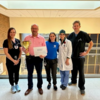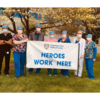Doctors, nurses, respiratory therapists and many other health care professionals have been busy at the bedside taking care of COVID-19 patients since March 2020.
COVID-19 affects different people in different ways. Some have had a wide range of symptoms, while others have had no symptoms at all.
Researchers at the CAMC Institute for Academic Medicine also have been busy during the pandemic, studying many aspects of the virus and participating in national trials as well as local studies.
In the early days of the pandemic, there were conflicting reports about how COVID-19 was spread, how to treat it, and who was affected most by it. For scientists, medical experts and health care workers it was like on-the-job training.
A variety of research teams from CAMC representing several specialties have scoured a multinational database to identify patients with confirmed COVID-19 infection to look at how COVID has affected patients with illnesses related to the kidneys, heart, brain and cancer. Scientists at CAMC also have looked at how COVID affects people based on sex and age.
Their examination of global data showed that females have lower COVID-19 mortality than males. They also found that COVID patients who had a stroke "had higher comorbidities including diabetes, high blood pressure, heart failure, obesity and history of stroke."
CAMC has developed a COVID-19 registry to monitor demographics, clinical findings, treatments and outcomes of patients and compare them to available national benchmarks. Research scientists are following trends in areas such as mortality, whether patients are cared for in an ICU vs. non-ICU, how long they are hospitalized, treatment and outcomes.
"This registry is an example of how research is entrenched in assisting in making everyday decisions, allowing them to be evidence-based," said Dan Lucas, PharmD, Center for Clinical Sciences Research, CAMC Institute for Academic Medicine.
Some COVID-19 statistics:
- 37.2% of patients have been admitted to an ICU.
- The mortality rate of patients in ICUs is 40.65%.
- Patients cared for in ICUs are hospitalized about 17 days.
- Patients cared for in non-ICU units are hospitalized about 8 days.
- The positivity rate for African Americans is 6.8% (3% of people in West Virginia are African American).
- More males (54.9%) have been infected than females.
CAMC started a second registry for outpatient administration of the monoclonal antibody (bamlanivimab). The purpose is to track demographics, risk factors and symptoms of patients receiving the drug, and adverse events and most importantly the rate of admission after infusion.
CAMC participates in the Society of Critical Care Medicine Registry receiving benchmark information on patients from more than 300 centers nationally/internationally.
Antibody testing
CAMC received multiple requests by community providers for COVID IgG antibody testing to help health care providers make informed recommendations about patient care.
Antibody tests check your blood to look for signs that you had a previous viral infection. Antibodies are proteins produced by the immune system to help fight off a particular infection. They are found in the liquid part of blood specimens (plasma).
"Additionally, the CAMC Clinical Trials Center enrolled front-line health care workers and essential workers within the community (police, fire, EMS, teachers, grocery store workers, restaurant workers, security, etc.)," said Kristi Sutphin, CAMC Clinical Trials Center. "The purpose of the study is to see who might have antibodies to COVID-19."
Convalescent plasma
The CAMC Clinical Trials Center worked with CAMC infectious disease physicians on the Mayo Clinic Expanded Access Program to provide severe and critically ill patients with COVID-19, convalescent plasma. Blood donated by people who've recovered from COVID-19 has antibodies to the virus that causes it. The donated blood is processed to remove blood cells, leaving behind liquid (plasma) and antibodies. These can be given to people with COVID-19 to boost their ability to fight the virus. Convalescent plasma therapy may help people recover from COVID-19. It may lessen the severity or shorten the length of the disease.
By participating in this program with Mayo, CAMC was able to provide convalescent plasma to patients earlier in the pandemic and before several hospitals in the surrounding area. Upon conclusion of this program at the end of August, CAMC continued to provide convalescent plasma through an Emergency use authorization to severe or critically ill patients with COVID. The CAMC Clinical Trials Center and CAMC virology lab worked closely with the American Red Cross to ensure the demand for the plasma was able to be met. CAMC was able to provide plasma in less than 12 hours from time of ordering to qualified COVID patients.
GI disorders
Doctors studied the effects of the COVID-19 pandemic on patients with underlying gastrointestinal (GI) disorders and related procedures. Patients with underlying GI disorders are considered to be at higher risk of poor outcomes compared to the general population. Researchers wanted to explore the risk of acquiring infection, baseline characteristics, outcomes and the prognosis to help doctors manage acute and chronic GI disorders.
Pediatric non-accidental trauma
Researchers looked at the impact of COVID-19 on the incidence of pediatric non-accidental trauma. The closure of classrooms and child care during the outbreak in combination with stresses placed on family members increases risks for child abuse and neglect. The aim of this study is to determine if the incidence of pediatric non-accidental trauma requiring visits to the emergency department and/or hospital increased during the pandemic.
Telemedicine usage
The COVID-19 pandemic forced many physician practices to reconsider the necessity of face-to-face office encounters. Seeking to reduce patient exposure, many offices transitioned to telemedicine. In analyzing the numbers of face-to-face, audio and audiovisual encounters, CAMC Urology reported that 82% of patients surveyed were likely to elect for a telemedicine encounter over a face-to-face encounter for a routine visit during future flu seasons.
Due to the nature of clinical trials, many of these studies will continue for several months and even years. It may take a while before full results are available on some studies. Patients will continue to be followed and scientists will continue to explore databases to learn more about COVID-19.
Publications
Researchers have studied all age groups and demographics during the past few months and have published several articles based on their findings. Below are links to some of the articles.
- Published article on The Impact of COVID-19 on Surgery and Procedures: A Commentary - Many hospitals have occasionally paused non-emergent and non-urgent surgical procedures during the pandemic.
- Could Gemfibrozil be used to enhance the body's immune response to COVID? - Can Gemfibrozil, a drug that lowers fats while raises good cholesterol, be used to enhance the body's immune response to COVID patients with associated medical conditions?
- Mousa AY, Broce M. The impact of COVID-19 on vascular training. J Vasc Surg. 2020 Jul 1; 72(1):380-381. PMID: 32360677 - COVID-19 has compounded challenges for teaching physicians and vascular trainees. The rotations for many third- and fourth-year medical students were suspended, often because of a shortage of medical supplies. This study takes a look at the impact on training.
- Richmond BK. The Coronavirus Pandemic: Experience from a Rural West Virginia Tertiary Care Hospital. Am Surg. 2020 Jul 15; 86(6):611-614. PMID: 32683967
- Mousa AY, Nanjundappa A. My vascular diary on coronavirus disease-19 pandemic and ideal health care settings. J Vas Surg Venous Lymphat Disord. 2020 Jul 28; S2213-333X (20):30419-4. PMID: 32736095 - Doctors looked at what we have learned and what we should know and created a diary examining best practices for the public and health care workforce.
- Adams E, Broce M, Mousa A. Proposed Algorithm for Treatment of Pulmonary Embolism in COVID-19 Patients. Ann Vasc Surg. 2020 Sept 4; S0890-5096(20):30768-8. PMID: 32891745 - There is mounting evidence that COVID-19 patients may possess a hypercoagulable profile that increases their risk for thromboembolic complications, including pulmonary embolism (PE). PE has been associated with an increase in morbidity, mortality, prolonged ventilation and extended ICU admissions.
- Richmond BK, Dean LS, Farrell TM. The Impact of the COVID-19 Pandemic on Surgical Practice in the Southeastern United States: Results of a Survey of the Membership of the Southeastern Surgical Congress. Am Surg. 2020 Sept 14; 86(8)916-925. PMID: 32926795 - The COVID-19 pandemic dramatically altered the delivery of surgical care. Members of the Southeastern Surgical Congress were surveyed regarding system adjustments, personal impact and productivity losses. Telemedicine was utilized by most respondents.
- Mousa AY, Broce M, Lucas BD Jr. Cardiovascular disease due to novel coronavirus and the search for investigational therapies [published online ahead of print, 2020 May 17]. J Vasc Surg. 2020;S0741-5214(20)31234-9. doi:10.1016/j.jvs.2020.04.503 - The primary purpose of the study was to investigate and to summarize the registered trials that listed COVID-19 as the primary condition. Within ClinicalTrials.gov, patients, family members, health care professionals and researchers can search and find ongoing and future trials for COVID-19.
- https://accpjournals.onlinelibrary.wiley.com/doi/10.1002/phar.2467 - A team investigated a multinational database of patients with COVID-19 with real-world data containing outcomes and their relationship to Hydroxychloroquine HCQ use. There was no statistically significant increase in mortality and mortality-arrhythmia with HCQ or HCQ-AZ.




